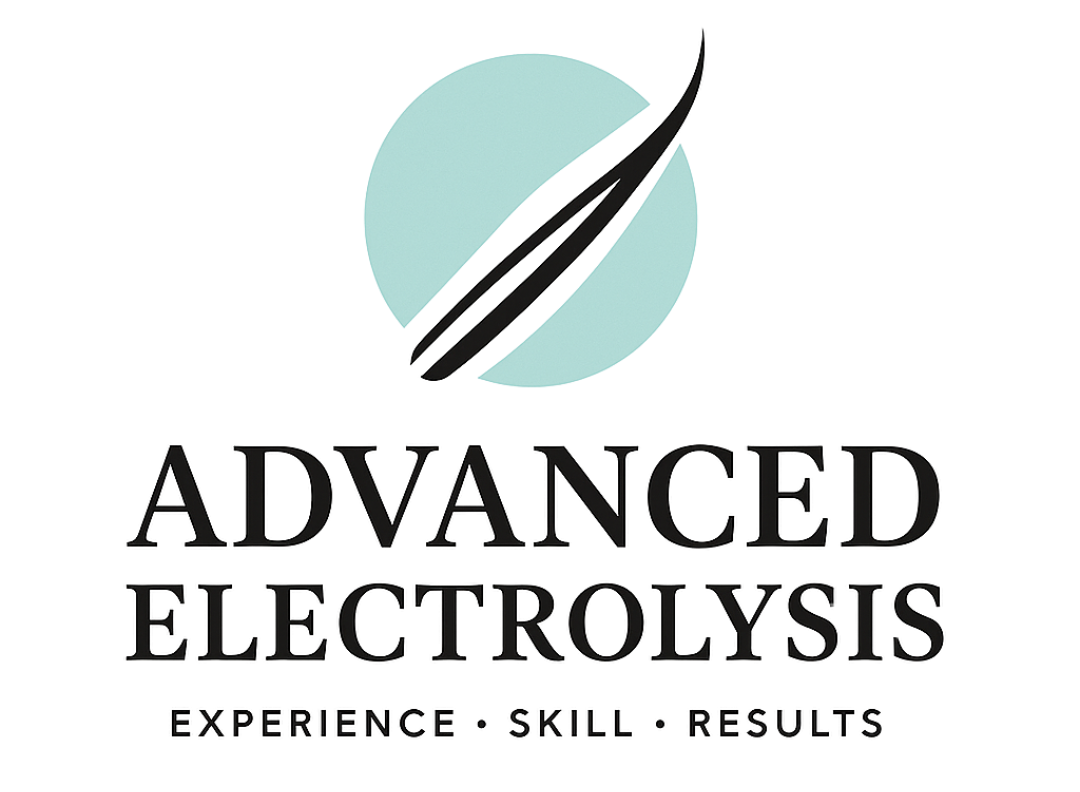
FAQs
What is electrolysis?
Electrolysis is a proven method of permanent hair removal. During treatment, a licensed electrologist inserts a very fine probe into the natural opening of the hair follicle and applies a small amount of electrical current. This energy destroys the follicle's ability to regrow hair, permanently.
Electrolysis has been safely used for over 150 years and remains the only FDA-approved method for permanent hair removal. Unlike laser hair removal—which can only reduce hair growth—electrolysis eliminates hair completely and permanently.
It is effective on all hair colors, all skin tones, and can be used on any area of the body, making it a truly universal solution.
What causes unwanted hair growth?
Unwanted hair growth can be the result of multiple factors, often working in combination. Common causes include: Heredity/genetics, Hormonal imbalances (such as PCOS), Life changes (puberty, pregnancy, menopause), Stress, Certain medications, including birth control pills and hormone therapy, Underlying medical conditions, Temporary hair removal methods, like tweezing or waxing, which can stimulate regrowth.
If you're experiencing persistent or excessive hair growth, electrolysis offers a safe, permanent solution—regardless of the cause.
How many treatments are necessary?
Electrolysis treatment plans are customized to each individual’s needs. Most clients find that weekly sessions are most effective in the beginning, as new hairs continue to emerge from beneath the skin’s surface.
Hair grows in cycles, and the life of a hair follicle—from its formation to visible growth—can take several months. Consistent treatments are necessary to catch hairs at the right stage of growth for successful removal.
As progress is made, sessions become shorter and less frequent. However, the total number of treatments will vary based on: Hair density and texture, Hormonal factors, Previous hair removal methods (e.g., waxing, tweezing), Stress and overall health, Medications.
Successful results require both time and commitment, and vary depending on your body and health history.
Does electrolysis hurt?
Sensitivity to electrolysis differs from person to person. Some clients describe the treatment as virtually painless, while others may experience mild discomfort, often compared to a quick pinch or warm sensation.
The level of discomfort also depends on the treatment area and your individual pain tolerance. For those with sensitive skin or lower tolerance, a topical numbing cream can be applied to minimize discomfort.
Most clients agree that the benefits of permanent hair removal far outweigh any temporary sensations during treatment.
Is electrolysis safe?
Yes, electrolysis is a very safe and well-established procedure. At Advanced Electrolysis, we follow strict universal safety precautions to ensure your health and comfort. These include: Thorough hand washing and the use of disposable gloves, Pre-sterilized, single-use probes, Disinfection with germicidal solutions, Dry heat sterilization of all reusable instruments, Cleansing of the treatment area with 70% isopropyl alcohol before each session.
Electrolysis has been used safely and effectively for over 150 years. In contrast, the long-term safety of laser hair removal is still under study, as it is a more recent technology.
Is electrolysis permanent?
Yes. According to both the FDA (U.S. Food and Drug Administration) and the AMA (American Medical Association), electrolysis is the only method of permanent hair removal. It has a proven track record of success spanning more than 150 years..
What areas of the body can be treated with electrolysis?
Electrolysis can be performed on any area of the body where you have unwanted hair. It is safe and effective for both women and men.
Popular areas for women include: Chin, upper lip, jawline, and throat, eyebrows and sides of the face, bikini line, underarms, and legs, chest, abdomen, and breasts, hairline, arms, fingers, and toes.
Popular areas for men include: Back and shoulders, neckline, beard, cheeks, and ears, brows and hands.
If you have a specific area in mind, we’re happy to discuss your treatment goals during your consultation.
Does my electrologist need to be licensed?
Absolutely. A licensed electrologist ensures that you receive professional, safe, and effective treatment. Licensing requirements vary by state. For example, in Massachusetts, electrologists must complete a minimum of 1,100 hours of training.
Choosing an unlicensed or poorly trained electrologist puts you at risk of skin damage, scarring, or infection. Always verify credentials and make sure your provider adheres to strict hygiene and safety standards.
What about laser hair removal?
Laser hair removal uses a beam of light to heat and damage the hair follicle, reducing future hair growth. It works by targeting melanin (pigment) in the hair, which is why it is most effective on individuals with light skin and dark hair.
However, laser has limitations: It is less effective on hair with low melanin (such as blonde, red, gray, or white hair). It may not be safe or effective for individuals with darker skin tones, due to difficulty distinguishing hair pigment from skin pigment. It does not guarantee full hair removal
According to the FDA, laser is classified as permanent hair reduction—not removal. It may reduce the number of hairs, but it does not eliminate them permanently. In contrast, electrolysis is the only FDA-approved method for permanent hair removal, effective on all skin tones and all hair types.
Ready to get started?
Call, text, or email us today to schedule your free consultation or book an appointment. We’re here to help you feel confident and informed every step of the way.
Directions to our office:
You’ll find us in the red brick office complex at the corner of Goodlette-Frank Road and 5th Avenue North.
Enter the complex from 5th Avenue North (look for the driveway).
Continue straight down the driveway.
Our building is the last red brick office on the right.
Parking is available directly in front of our office.
We’re located on the first floor, in the right corner suite.
If you need help finding us, feel free to call—we’ll be happy to guide you!
